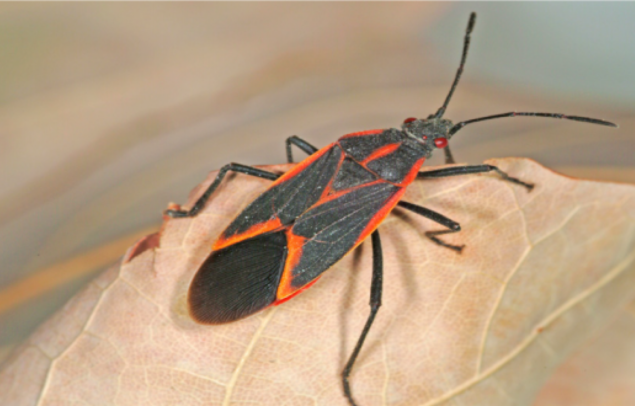As compared to other pests’ species, the boxelder bugs live with a concise life span, which mayextend to approximately one year.The nymphs come out from eggs within fourteen days. The wingless nymphs have to pass through various phases of molts, to go into shape of adult bugsas compared to nymph, only adult bugs are found to survive in the winter.The adult boxelder bugs hibernate in the whole of winter, but they may be occasionally seen on the surface in case of any source of heat in the site. Boxelder bugs are known to be nuisance pests.
WHAT ARE BOXELDER BUGS?
The boxelder bugs belong to a family of true bugs. The boxelder bugs derive their name due to their frequent presence and their abode around the boxelder trees. This species of bugs originated from the western states, but its presence can be observed in other areas, where ever boxelder trees are grown. The nymph Boxelder bugs are initially found in red color, but when these bugs developed and became adult, they changed into black color, having some red and orange marks and patterns on their tops. The boxelder bugs are half an inch in size, and they keep six legs and two antennae. Boxelder bugs preferred to live in large congregational groups because of this habit. They are known to be semi-social. Both adults and nymphs possessa pair of odor glands on the abdomen’s backside that releases monoterpene hydrocarbons, which may be used as a tool of communication. In case of confrontation with other males, the male boxelder bugs are found to release secretions.

WHAT DO BOXELDER BUGS EAT?
The fallen seeds of boxelder trees are the favorite food of the boxelder bugs, but they are also found to eat the newly grown leaves of maple trees or boxelder trees. The boxelder bugs suck the juice of out of unripe seeds and newly grown leaves of boxelder and maple tree, but due to their feed from plants, they maycause damage to plant or tree. In some areas, these bugs are observed to consume the fruit of apple and plum trees. One of the unique qualities of boxelder bugs is that they can generate bad, irritating odor, which proved helpful to save them from predators.
ARE BOXELDER BUGS HARMFUL?
Boxelder bugs are known to be nuisance insects that presence in-room or yard irritates the humans. Commonly these bugs are not reported to bite humans or to transmit disease. In rare cases, these bugs are observed to defensive biting in reaction to any danger. Boxelder bugs are not found to be detrimental to plants or humans, but they discharged yellowish-red feces, which causes the stain to the floor, curtain, and leaves.On crushing a boxelder bug, they create an unpleasant and irritating odor.Study upon these bugs suggests that these bugs are non-stingy, and they never bite, but their sharp and pinching mouthparts may spike the skin, which might make the skin inflamed having resemblance with the mosquito bite.
BOXELDER BUG LIFE SPAN.
Boxelder bugs are found to breed seasonally. After getting a rise from hibernation, these bugs preferred to feed themselves before starting a mate. The long wavy antennae of boxelder bugs helped them to find a mate. Male boxelder bugs are observed to release anexocrine compound from abdominal glands during mating, which allures the females. Generally, male boxelder bugs are smaller than female boxelder bugs, and during mating male, boxelder bugs are found to be passively carried by the female boxelder bugs. Mating between male and female boxelder bugs happened by the rear to rear body contact. Female and male boxelder bugs are capable of performing multiple mates, and male boxelder bugs are observed to guard the females while they lay eggs.Boxelder bugs are known to be hemimetabolous insects, which means that they evolve into three phases.
- Eggs.
In spring, female bugs lay eggs in chinks in barks of the host trees and leave litter. The brownish-red color of their eggs helps them to looks blended with the host tree.
- Nymph.
The nymphs come out from eggs within fourteen days. The wingless nymphs have to pass through various phases of molts, to come into the shape of adult bugs.
- Adults.
They are capable of flying to the extent of two miles to find shelter from the severity of cold by overwintering place. They hibernate in the whole of winter, but they may be occasionally seen on the surface in case of any source of heat in the site.


